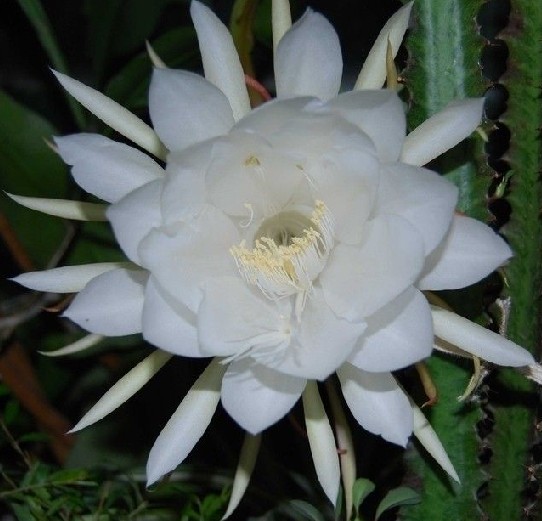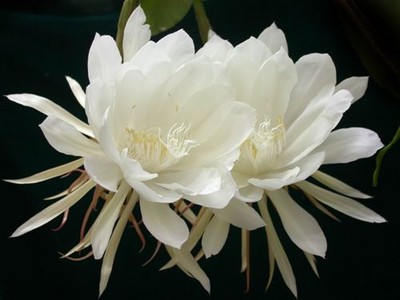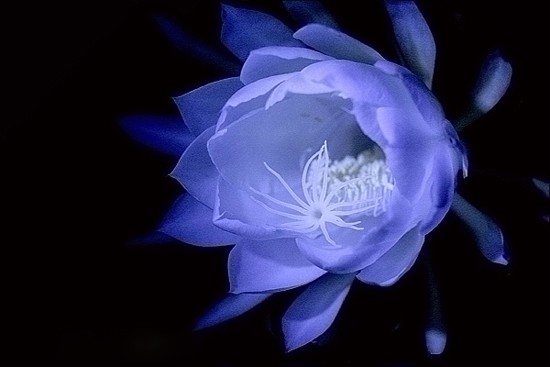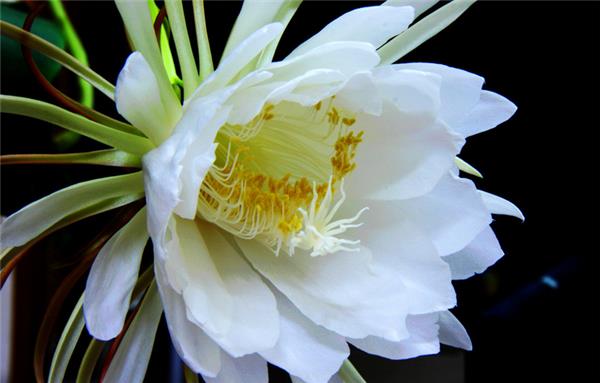When does epiphyllum bloom?
We all know that it is not easy for epiphyllum to blossom once, but there is no way to make epiphyllum blossom. Let's look at how to make epiphyllum blossom from several different aspects and when to blossom epiphyllum. How long does it take to bloom in the pan?

When does epiphyllum bloom?
Epiphyllum blossoms usually in summer and autumn in the dead of night, it is the time to blossom in the epiphyllum and show its appearance. Around 9 o'clock in the evening is the time when it opens the most charming posture, the purple flower stalk holds up a large epiphyllum, the white petals are neatly wrapped in one layer, and the heavy branches are shaking leisurely. In the tremor, the petals slowly opened and stretched, showing a beautiful face. The dense and fine white filament spins out from the core, and the top of the filament is a yellow slightly dilated anther, which is the stamen. Epiphyllum pistil is very special, surrounded by stamens, slightly thicker than filaments, but also white, especially the tip of the stigma, with a small chrysanthemum-like white flower. Elegant, white, flirtatious, proudly raising his head and blooming. The whole flower is beautiful and elegant, fragrant and brilliant. Therefore, he enjoys the reputation of "beauty under the moon". Interestingly, when the flowers gradually unfold, they wither slowly after 1-2 hours, and the whole process takes only about 4 hours. Therefore, it is said that it is a flash in the pan.

How long does the epiphyllum blossom:
The reason why there is a flash in the pan is that the flowering period of epiphyllum is a little shorter than that of other flowers. Epiphyllum usually wither in 3 to 4 hours after it is in full bloom, because the petals of epiphyllum open when they are in full bloom. It is very easy to lose water. In the case of lack of water, the petals will close and the flowers will wither quickly.
Culture methods and matters needing attention of epiphyllum potted cultivation
First, basin soil
Epiphyllum likes humus-rich, well-drained, loose and fertile slightly acidic sandy soil. The proportion of basin soil is generally as follows: rotten leaf soil, ∶ garden soil, ∶ sand soil = 4 ∶ 4 ∶ 2. After the soil is ready, it is best to be sterilized in the sun. When planting, put a layer of broken tiles or bricks at the bottom of the basin to increase ventilation and drainage.
Second, watering
Epiphyllum likes moist soil and high air humidity and is afraid of waterlogging. When the temperature is low in late autumn, winter and early spring, epiphyllum is in a semi-dormant state. Watering should be strictly controlled to keep the basin soil in a dry state. When the temperature rises in spring, epiphyllum begins to grow again, which can gradually increase the amount of water and keep the soil moist. When growing vigorously, in addition to watering, water should also be sprinkled around the plant to increase air humidity and strengthen ventilation.

III. Fertilization
Epiphyllum prefers fertilizer and has more requirements for fertilizer. It is better to use rotten organic fertilizer, plus a small amount of bone meal or superphosphate. Add it when preparing the soil and mix it with the basin soil evenly. The application amount is from 1 stroke 20 to 1 stroke 30 of the basin soil. After the new stem grows in spring, topdressing begins. If the leaves turn yellow during the growth period, the ferrous sulfate solution should be applied once, and 1000 times potassium dihydrogen phosphate should be applied once after the flower bud. After the flower withered, additional phosphorus and potash fertilizer should be applied every 20 days or so, and fertilization should be stopped at the end of autumn.
IV. Reproduction
The propagation with flaky branches can be planted in the greenhouse all the year round, but it is best from April to May. Cuttings should be selected for the next year slightly old and robust flake branches (too tender and easy to rot), cut into a section of 10 to 15 meters, dry for 2 to 3 days, after the cut is dry, cut into the substrate or sand, the insertion depth is about 1x3 of the cuttings (not too deep), if the soil is moist, do not water temporarily, and then control the soil in a slightly moist and dry state. Roots begin to take root in about 20 days. When the roots grow to 4 to 5 meters, they can be planted in pots and properly managed, and 2-year-old seedlings can also blossom.

5. Change the basin
The young plants of epiphyllum change their pots once a year, and the formed plants usually change their pots every 2 to 3 years. The basin change can be carried out when the spring temperature is above 12 ℃, or in September. Before changing the basin should stop watering, so that the basin soil dry after the basin, off the basin should be handled gently, to avoid touching the plant. After removing the pot, remove the old soil outside the root, trim the dead root and cut the root, put it in a semi-shady place after planting, do not water it temporarily, and water it slightly after 2 days to keep the basin soil dry.
I believe that after reading the above articles, you have a certain understanding of the relevant content of epiphyllum. I hope the above content can explain to you, and please continue to follow our website for more wonderful content.
I hope the above content can explain to you, more wonderful content, please continue to follow our website.
Related
- Wuhan Hospital Iron Tree Blooming Result Was Instantly Frightened by the Gardener Master
- Which variety of camellia is the most fragrant and best? Which one do you like best?
- What is the small blue coat, the breeding methods and matters needing attention of the succulent plant
- Dormancy time and maintenance management of succulent plants during dormancy
- Minas succulent how to raise, Minas succulent plant pictures
- What are the varieties of winter succulent plants
- How to raise succulent plants in twelve rolls? let's take a look at some experience of breeding twelve rolls.
- Attention should be paid to water control for succulent plants during dormant period (winter and summer)
- Watering experience of twelve rolls of succulent plants
- Techniques for fertilizing succulent plants. An article will let you know how to fertilize succulent plants.



